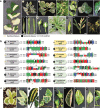High-throughput discovery of plastid genes causing albino phenotypes in ornamental chimeric plants
- PMID: 36643742
- PMCID: PMC9832966
- DOI: 10.1093/hr/uhac246
High-throughput discovery of plastid genes causing albino phenotypes in ornamental chimeric plants
Abstract
Chimeric plants composed of green and albino tissues have great ornamental value. To unveil the functional genes responsible for albino phenotypes in chimeric plants, we inspected the complete plastid genomes (plastomes) in green and albino leaf tissues from 23 ornamental chimeric plants belonging to 20 species, including monocots, dicots, and gymnosperms. In nine chimeric plants, plastomes were identical between green and albino tissues. Meanwhile, another 14 chimeric plants were heteroplasmic, showing a mutation between green and albino tissues. We identified 14 different point mutations in eight functional plastid genes related to plastid-encoded RNA polymerase (rpo) or photosystems which caused albinism in the chimeric plants. Among them, 12 were deleterious mutations in the target genes, in which early termination appeared due to small deletion-mediated frameshift or single nucleotide substitution. Another was single nucleotide substitution in an intron of the ycf3 and the other was a missense mutation in coding region of the rpoC2 gene. We inspected chlorophyll structure, protein functional model of the rpoC2, and expression levels of the related genes in green and albino tissues of Reynoutria japonica. A single amino acid change, histidine-to-proline substitution, in the rpoC2 protein may destabilize the peripheral helix of plastid-encoded RNA polymerase, impairing the biosynthesis of the photosynthesis system in the albino tissue of R. japonica chimera plant.
© The Author(s) 2023. Published by Oxford University Press on behalf of Nanjing Agricultural University.
Figures





Similar articles
-
Leaf variegation caused by plastome structural variation: an example from Dianella tasmanica.Hortic Res. 2024 Jan 10;11(3):uhae009. doi: 10.1093/hr/uhae009. eCollection 2024 Mar. Hortic Res. 2024. PMID: 38464478 Free PMC article.
-
Comprehensive genomic analyses with 115 plastomes from algae to seed plants: structure, gene contents, GC contents, and introns.Genes Genomics. 2020 May;42(5):553-570. doi: 10.1007/s13258-020-00923-x. Epub 2020 Mar 21. Genes Genomics. 2020. PMID: 32200544
-
Differential regulation of genes transcribed by nucleus-encoded plastid RNA polymerase, and DNA amplification, within ribosome-deficient plastids in stable phenocopies of cereal albino mutants.Mol Genet Genomics. 2002 Mar;267(1):27-37. doi: 10.1007/s00438-001-0627-4. Epub 2002 Feb 8. Mol Genet Genomics. 2002. PMID: 11919712
-
The plastid transcription machinery and its coordination with the expression of nuclear genome: Plastid-Encoded Polymerase, Nuclear-Encoded Polymerase and the Genomes Uncoupled 1-mediated retrograde communication.Philos Trans R Soc Lond B Biol Sci. 2020 Jun 22;375(1801):20190399. doi: 10.1098/rstb.2019.0399. Epub 2020 May 4. Philos Trans R Soc Lond B Biol Sci. 2020. PMID: 32362266 Free PMC article. Review.
-
From chloroplasts to "cryptic" plastids: evolution of plastid genomes in parasitic plants.Curr Genet. 2008 Sep;54(3):111-21. doi: 10.1007/s00294-008-0208-8. Epub 2008 Aug 12. Curr Genet. 2008. PMID: 18696071 Review.
Cited by
-
The evolutionary dynamics of organellar pan-genomes in Arabidopsis thaliana.Genome Biol. 2025 Aug 11;26(1):240. doi: 10.1186/s13059-025-03717-0. Genome Biol. 2025. PMID: 40790212 Free PMC article.
-
PEP-ASSOCIATED PROTEIN 3 regulates rice tiller formation and grain yield by controlling chloroplast biogenesis.Plant Physiol. 2024 Jan 31;194(2):805-818. doi: 10.1093/plphys/kiad536. Plant Physiol. 2024. PMID: 37819034 Free PMC article.
-
Leaf variegation caused by plastome structural variation: an example from Dianella tasmanica.Hortic Res. 2024 Jan 10;11(3):uhae009. doi: 10.1093/hr/uhae009. eCollection 2024 Mar. Hortic Res. 2024. PMID: 38464478 Free PMC article.
-
Molecular insights into the mechanisms of a leaf color mutant in Anoectochilus roxburghii by gene mapping and transcriptome profiling based on PacBio Sequel II.Sci Rep. 2023 Dec 20;13(1):22751. doi: 10.1038/s41598-023-50352-5. Sci Rep. 2023. PMID: 38123722 Free PMC article.
-
Chloroplast genome assembly of Serjania erecta Raldk: comparative analysis reveals gene number variation and selection in protein-coding plastid genes of Sapindaceae.Front Plant Sci. 2023 Sep 26;14:1258794. doi: 10.3389/fpls.2023.1258794. eCollection 2023. Front Plant Sci. 2023. PMID: 37822334 Free PMC article.
References
-
- Analytics AM. Indoor plant comprehensive study by type (shade-loving plants, low light plants, high light plants, others), application (commercial, household, others), distribution channel (online, offline) players and region - global market outlook to 2025 <https://www.advancemarketanalytics.com/reports/66903-global-indoor-plant...>. 2021.
-
- Nati P. Florentina phytologica observatio de malo Limonia citrata-aurantia. In: Florentiae Vulgo la Bizzaria. Florence: Italy, 1674.
-
- Tilney-Bassett RA. Plant Chimeras. London: (Edward Arnold (Publishers) Ltd.; 1986.
-
- Frank MH, Chitwood DH. Plant chimeras: the good, the bad, and the 'Bizzaria'. Dev Biol. 2016;419:41–53. - PubMed
-
- Bock R. In Cell and Molecular Biology of Plastids 29–63. Berlin/Heidelberg, Germany: Springer; 2007.
LinkOut - more resources
Full Text Sources

